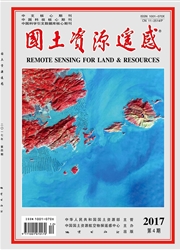

 中文摘要:
中文摘要:
机载LiDAR技术为探测建筑物提供了大量三维点云坐标。为了能从植被中有效识别建筑物面域,首先利用渐进式TIN加密法识别非地面点云,经过移除低于地面3m的点云和孤立点云后生成非地面点云的二值化格网,依据自定义的分割算子打断建筑物和植被间的可能连接;然后通过区域生成算法以高差阈值来聚类二者的面域,并使用大坡度密度阈值来提取建筑物的面域;最后使用形态学闭算子填充面域孔洞并平滑其边缘。选取3个典型的复杂城市区域进行测试,结果显示,各区域的提取质量与完成率均高于91%,表明该算法能够达到自动识别建筑物的目的。
 英文摘要:
英文摘要:
Airborne LiDAR technology provides large quantities of three-dimensional point clouds coordinates for detecting buildings.To effectively identify the building region from the vegetation,the authors adopt a progressive densification TIN method to filter no-ground points.After removing some point clouds whose height is less than 3m from ground surface and isolated point clouds,a binary grid cell is produced based on no-ground points.Next,defined segmentation operators are used to disconnect the possible link between buildings and vegetation.Two kinds of regions are clustered based on height difference criteria using the region growing method.Then building regions are extracted according to large slope density values.Finally,a morphological closing operator is applied to fill small holes and smooth edges of extracted building regions.Three typical areas with complex urban conditions were selected to test this algorithm.The results show that this algorithm gives a comparative performance with a precision of over 91 percent in quality and completeness.The results also demonstrate that this algorithm can automatically recognize buildings.
 同期刊论文项目
同期刊论文项目
 同项目期刊论文
同项目期刊论文
 Application of Lodrigues Matrix in Coordinate Transformation of Similar Material Simulation Experime
Application of Lodrigues Matrix in Coordinate Transformation of Similar Material Simulation Experime The Research on Forest Resources Change Detection Based on C5.0 Algorithm and Neighborhood Correlati
The Research on Forest Resources Change Detection Based on C5.0 Algorithm and Neighborhood Correlati Study of Earthquake Disaster Population Risk Based on GIS a case study of Wenchuan earthquake region
Study of Earthquake Disaster Population Risk Based on GIS a case study of Wenchuan earthquake region Based on GIS and MATLAB Technology Forecast the Dynamic Variation of the Groundwater in Minqin Oasis
Based on GIS and MATLAB Technology Forecast the Dynamic Variation of the Groundwater in Minqin Oasis 期刊信息
期刊信息
